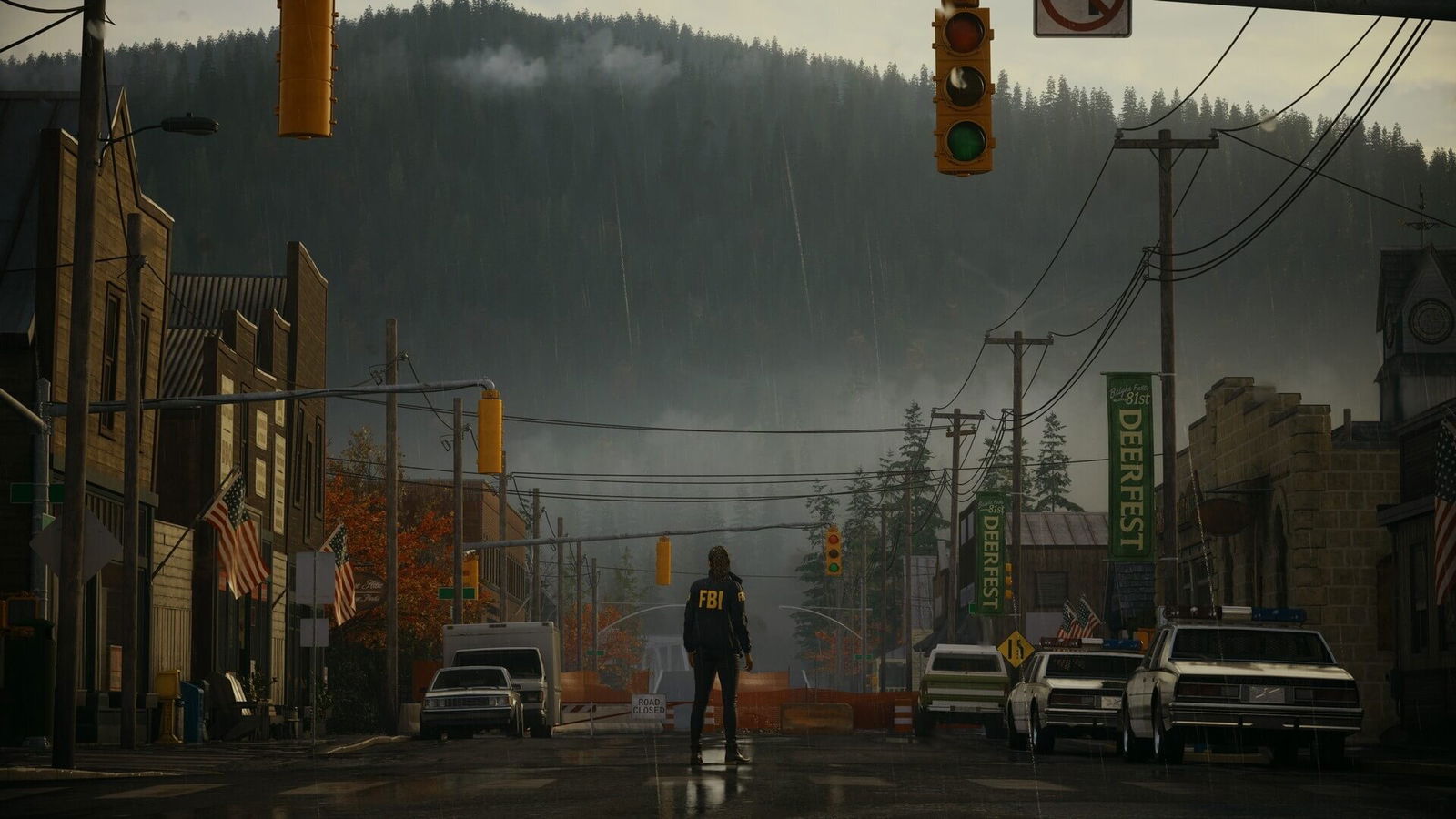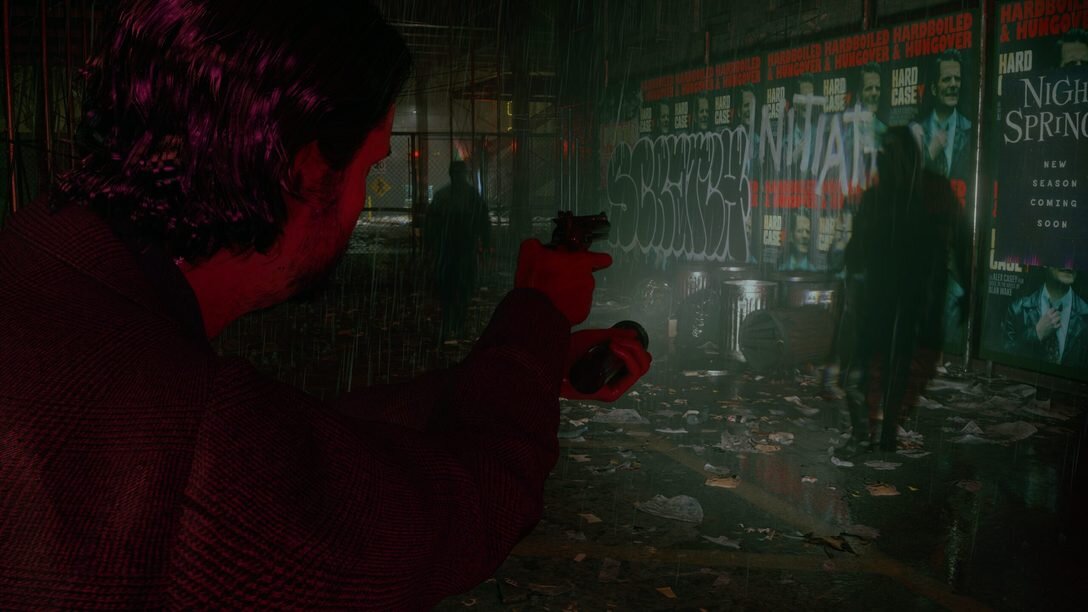You open this review and read the first sentence about Alan Wake 2. Perhaps the first paragraph will tell you about how it connects to the original game, which came out in 2010. Or it will tell you that a new character acts as an audience surrogate to fill in those who missed the original. Perhaps you’ll learn that Alan Wake 2 also has major ties to another remedy game, 2019’s Control. And that it takes inspiration from Twin Peaks and True Detective. Maybe you’re getting tired of me writing like this.
Game Name: Alan Wake 2
Platform: PlayStation 5 (Reviewed), Xbox Series X/S, PC
Publisher: Epic Games Publishing
Developer: Remedy Entertainment
Release Date: October 27, 2023
Price: $59.99 (PS5 and Xbox X/S), $49.99 (PC)
Alright, I’ll stop there. But if you got a kick out of my little meta-introduction, you may very well love Alan Wake 2. Set in a world of unexplainable phenomena, the game continues the story of the titular horror-mystery writer who finds that the stories he writes come to life in reality. 13 years have passed since the original game came out. This also proves true for the story, with Alan Wake trapped for that time in the otherworldly Dark Place that he wrote himself into to save those around him.
Alan Wake Up
But the game doesn’t start with Alan Wake. Instead, it places players into the shoes of Saga Anderson, an FBI agent investigating ritualistic murders. This brings her to Bright Falls, the town where Wake disappeared years prior. Alone with her partner Alex Casey, Anderson investigates the cult, stumbling upon the story of Alan Wake along the way—whereupon he becomes playable as well. At a certain point, players can switch back and forth between Wake and Anderson’s stories, tackling them in whichever order they choose.
With Anderson, the gameplay focuses on investigation. The game makes use of a novel “Mind Place” mechanic, a kind of menu that puts Anderson into her own mental office so players can sift through clues and make deductions. This consists of taking clues gathered and posting them to corresponding case files. The game tells you if you’re hot or cold, but the evidence board design still makes connecting the dots an active treat.
Though Alan Wake’s sections have their own Mind Place, here called the Writer’s Room, they still feature a unique puzzle mechanic. Since Wake can change reality through his stories, the game lets players assign plot devices to locations. For example, an eerie hotel can relay the story of a Shining-influenced haunting, or a murder at a Sleep No More-inspired immersive theater show. Switching plot devices changes the topography as well as the information Wake can glean from the area. Choosing the “correct” option advances Wake’s plot, but players can assign any plot device to a location and have the game reward them.
The Remedy Cinematic Universe
While the puzzle mechanics prove fun in their versatility, the storytelling comes along as top-notch. Fans of cinema, directors Sam Lake and Kyle Rowley intersperse full-motion video scenes filmed with real actors among the rendered cutscenes. While this appeared in the first Alan Wake and in Control in the form of optional videos, most of them feature more prominently in the plot here.
Speaking of performances, Alan Wake 2 shines a bright light on this area. Matthew Porretta and Melanie Liburd voice Wake and Anderson respectively, delivering performances that feel natural, even as supernatural events unfold around them. Of course, a game about writing needs good writing, and the dialogue can be punchy, unnerving, and even humorous, depending on what a scene requires. It serves as another homage to Twin Peaks and David Lynch, effortlessly shifting through the various tones in a way that’s never jarring. Though the surreal story threatens to buckle towards the end, it stays engaging throughout.
And boy is this game dripping with style. There’s one really wild moment I won’t spoil. But let’s just say, if you were one of the lucky few who stumbled upon Porretta’s “Dynamite” performance in Control, you won’t come away disappointed here. Remedy games excel at world-building. When the game embraces the wonderful and strange (there’s that Twin Peaks again), it really clicks into gear. One highlight involves an entirely missable side quest involving meeting the mayor of Bright Falls, and it’s a doggone delight.
The Light and Dark of Combat
But unfortunately, the same can’t be said about every gameplay mechanic. While the combat marks an improvement over the original, it’s still the weakest link. Once again, players defeat shadowy enemies by first shining a flashlight at them to dispel the darkness. Entering corporeal form, players can then shoot or hit them with everything they’ve got. New upgrades help shake things up, along with the variety of weapons. It’s not the combat itself that’s the biggest problem, but the way it gels with other gameplay mechanics—or rather, doesn’t. Boss battle designs prove especially dated in this regard.
An egregious example comes during an early boss fight. The game tells players to escape after defeating the boss by shooting an orb, forcing them to flee with an enclosing wall. Except it’s not an escape at all. Players can only continue by defeating the boss a few more times. So, what’s the point of forcing players to run? Why introduce the orb at the start of the battle? Why have to defeat the boss again? One of these would be enough. But now and then, Alan Wake 2 introduces one mechanic to override it with another.
Even the boss battles that have clear mechanics simply aren’t fun for the most part, often involving defeating an enemy over and over while having to perform some kind of task to rid them for good. One exception is a water-logged battle towards the end, focusing more on dodging and retaliating. The second part of this tougher battle rewards patience and timing. I wish the game focused more on these skills rather than how well you can interact with various objects during a fight.
Escape From New York
Still, these flaws only stick out since everything else gels so well. The storytelling proves masterful, along with the overall design. Even if the combat isn’t the best from a gameplay perspective, it is suitably scary. Enemies move differently than they did in the first game. Those in Wake’s story move incredibly slowly—until they suddenly warp forward like one of Doctor Who’s Weeping Angels. Meanwhile, Saga’s plow straight ahead. It sounds like a small distinction, but it turns a campy aspect of the first title into something genuinely creepy.
The environment is also fittingly macabre and luscious, with dense fall foliage for the Washington State sections and gritty city streets filled with graffiti and grime for the Dark Place parts—based on New York City. And these streets and woods hold secrets, with various side activities to take part in. These include everything from finding hidden words to unlock upgrades to solving side quests to procure new items. While Alan Wake 2 is a mostly linear game, there’s always something intriguing off the beaten path.
Review Disclosure Statement: The Outerhaven paid for the copy of Alan Wake 2 for review purposes. For more information on how we review video games and other media/technology, please review our Review Guideline/Scoring Policy.
Affiliate Link Disclosure: One or more of the links above contain affiliate links, which me
Alan Wake 2 Review
Summary
Alan Wake 2 takes its action-horror predecessor and dregs it out of the water with a fresh survival horror overhaul. Though certain mechanics seem like they’re still stuck in 2010, the vast majority of the sequel feels ahead of its time. The story is stylish, suspenseful, and scary, yet isn’t afraid to get a little silly. Alan Wake 2 is one of Remedy’s best games yet, and certainly its most artistic.
Pros
- A masterfully mind-bending and suspenseful horror story
- Likable characters with fun quirks bolstered by earnest performances
- Puzzle gameplay that plays with the environment in unique ways
- Stunning environment design
Cons
- Tedious boss battles
- Combat doesn’t often gel with other gameplay mechanics
- Ending may leave some feeling left in the dark
-
4







